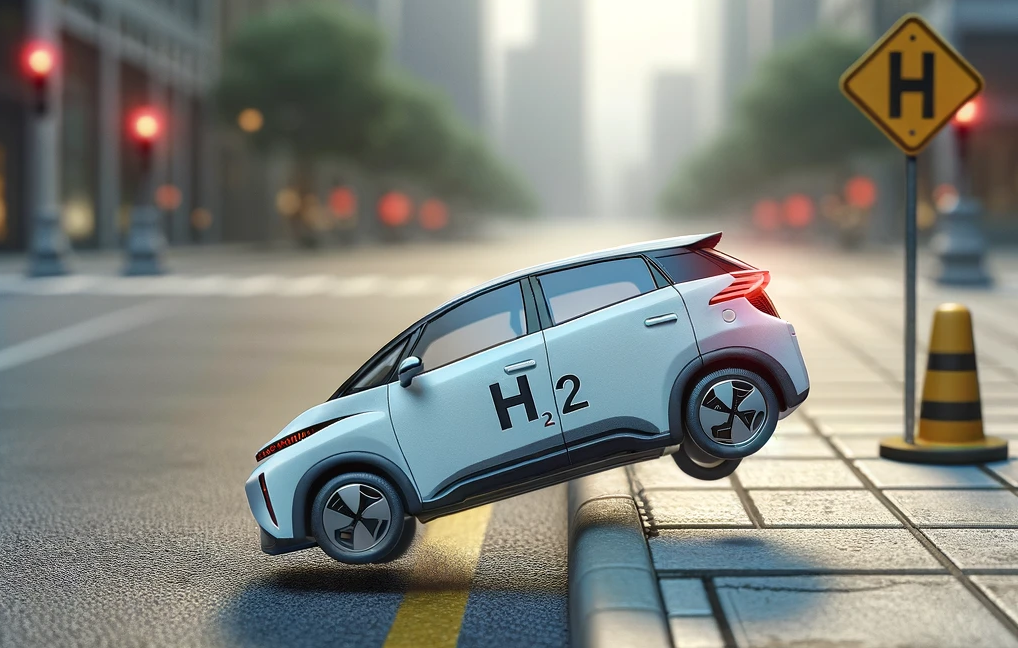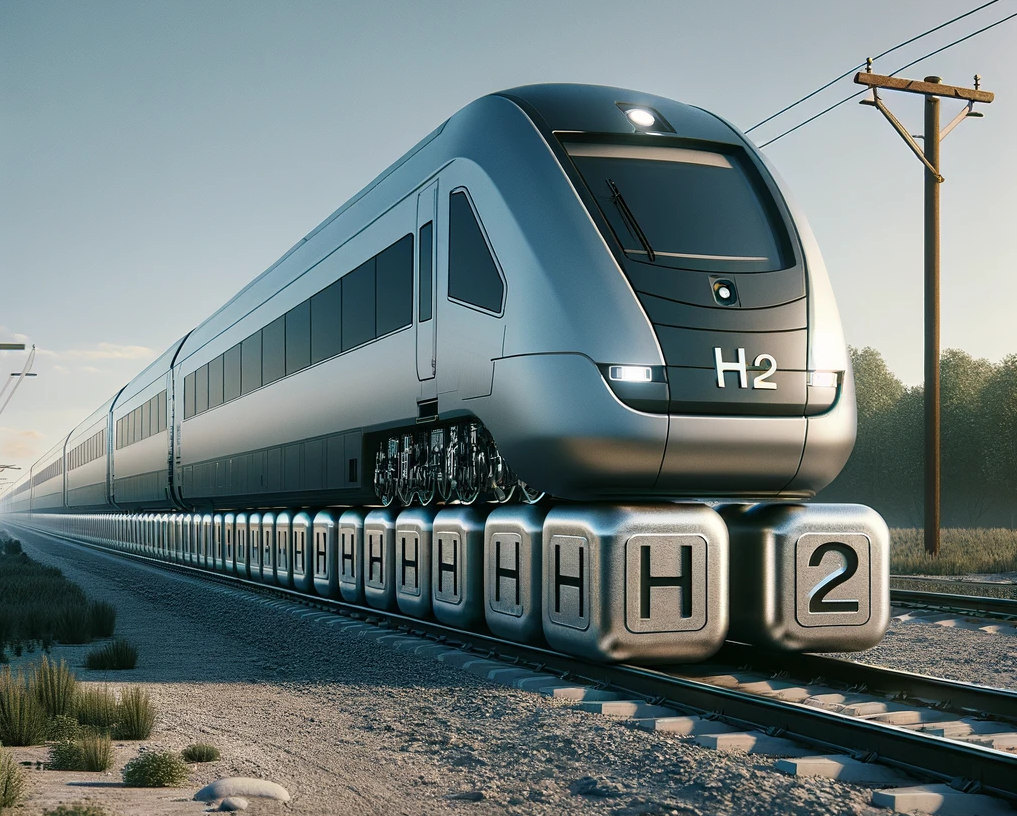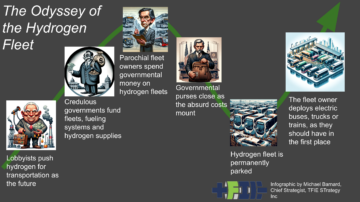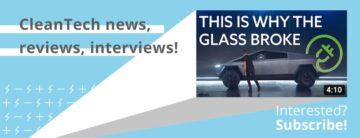Sign up for daily news updates from CleanTechnica on email. Or follow us on Google News!
Getting ChatGPT and its image-generating sibling DALL-E to put square wheels on vehicles is as tough as getting hydrogen to make any fiscal sense for ground transportation. Unless you ask it to put square wheels on a hydrogen vehicle, it seems.
Michael Sura’ is a Slovakian transportation expert, with years as an energy and renewables specialist with the country’s largest energy supplier and now years advising on transportation specific issues with the Ministry of Transport and chairing the postal service’s supervisory board. And he’s a regular on LinkedIn discussions related to transportation, publishing his analyses and infographics about alternative energy pathways for ground transportation.
One of his favorite phrases is that hydrogen is a “square wheel” for transportation, similar to Paul Martin’s comments that it’s both ineffective and inefficient. Martin, of course is a chemical engineer, a hydrogen expert professionally and co-founder of the Hydrogen Science Coalition.
But Sura’ has had to make do with decorating his material with old cartoons about square-wheeled mule carts. Until now. A thread on LinkedIn about failing to get ChatGPT to put square wheels on mule carts to update the old image by yet another person strongly engaged in the energy transition, Michael Hamilton of global firm Bekaert, VP of commodity sourcing, led to me trying a couple of hacks.
And sure enough, with minimal iteration, putting square wheels on a Toyota Mirai was pretty easy to do. Yet more fiddling resulted in zero ability to convince either of the two AI image generating tools I use to put square wheels on any type of cart, even after feeding it one of the old cartoons of exactly that and having it describe it as having square wheels. The best I could do was to get a wooden tub up on square wooden blocks.

For something like 14 months I’ve been exploring the iterating limits of a couple of AI image generating tools and it was interesting to run up against this limit. Training data is training data and in virtually all training data wheels are round. Fascinating that Toyota Mirai’s were somehow unique.
And so I bequeath to the world of transportation decarbonization communication an image of a square-wheeled Mirai.
But is that fair? Is hydrogen really like a square wheel? It sure is, and even many die hards are realizing it.

Toyota is removing the Mirai from the market after a decade, while still remaining committed to fuel cells for larger vehicles. That’s in the context of hydrogen fuel cell light vehicle sales falling off their tiny curb in the past year. There are still a couple of fuel cell cars available, but they just aren’t selling.
And hydrogen refueling stations are going in reverse, as I recently noted, with more and more closing permanently globally in addition to the ones which are out of service for extended periods of time due to a lack of hydrogen or maintenance issues, mostly with compressors. There are plans to build five more in the UK, but given that eight have shut down in the past year and a half, it’s not only unlikely the five will proceed, but if they do get built that will still be negative inertia.
The government of Quebec had a trial of 50 Mirais running for the past few years, refueling them at the single hydrogen station in the country that isn’t in British Columbia, one on the outskirts of Quebec City on the premises of an Esso station. It’s going to be a pretty dusty station now, as those 50 cars were quietly returned to Toyota and not replaced with new ones, leaving perhaps a dozen or two operating hydrogen cars in the entire province.
Not to be outdone, Shell actually refused $48 million of California’s money to build a bunch more hydrogen refueling stations last year and now has shut down all of its light vehicle stations in the state. I’m pretty sure that no one is updating dashboards of refueling stations there out of despondency.
The Hydrogen Fuel Cell Partnership, formed by a bunch of hydrogen faint-hopers in the state, went national in 2022 and nobody noticed. Their dashboard shows 55 stations in total in the state, exactly what it was in the first half of 2021, three years ago. All that work, no movement. And that’s theoretically operating stations, as their dashboard shows that many are closed at the time of writing, have limited hydrogen availability or have one or both pressures offline. In fact, 29 of the 55 stations are incapable of pumping hydrogen at all the pressures and quantities that they are designed to at this moment in time.
That’s not unusual. US DOE’s reports from the period, which I pulled apart to look at the reality recently, when they still reported on the program before stopping in what one presumes was shame in the middle of 2021, show that across the fleet of stations they were offline 2,000 more hours than they were actively pumping hydrogen over six months. Their maintenance costs per year were 30% of the capital cost of building them, a full order of magnitude above total cost of ownership study assumptions. That equated to $9.23 per kilogram of hydrogen delivered. No wonder hydrogen costs $36 per kilogram retail in California.
Hydrogen fuel cell bus fleets in the state were equally challenged, seeing 50% more maintenance costs per year than diesel buses and double that of battery electric buses. Once again, US DOE reporting which I pulled apart to see what they said.
But back to stations. True Zero operates the majority of the remaining stations in California. The Hydrogen Fuel Cell Partnership’s dashboard claims they are operating 38. True Zero only claims that they are operating 34. True Zero claims that they are opening more and with a big pot of additional money from the IRA being wasted on hydrogen for transportation in California’s $1.2 billion hydrogen hub, they probably will because despite no usage to speak of, they will undoubtedly be made whole off taxpayer money.

Into this morass of expensive failures, of course, California announced recently that it was buying six more hydrogen trains from Stadler for passenger rail segments to add to the four that it already had on order. Naturally, $407 million of governmental funding was behind that. The trains aren’t expected to enter service until 2027 and it’s really doubtful that they’ll stay in service long given the high cost of hydrogen and maintenance.
After all, a European Stadler sales executive said the quiet part out loud recently.
“If the tenders are open to all technologies and the only condition is a potentially CO2-free drive, we have observed that the battery almost always prevails over hydrogen,”
Why? Hydrogen trains — and buses, trucks, cars, and every other mode of transportation — are more expensive to maintain and more expensive to fuel than every alternative. Their total cost of ownership is multiple times more, three times in the case of trains. The only time hydrogen trains are actually sold is when the tenders explicitly called for hydrogen trains, and that is almost entirely because governmental money is earmarked for hydrogen fleets.
Clearly ChatGPT thinks hydrogen is a square wheel for trains too, as it provided the image above with little prompting.
It’s remarkable that hydrogen for energy proponents can look at 25 years of failures, challenges, retrenching, and falling sales and still hold a pale blue torch for the molecule. It’s not a technology going through teething pains, it’s a technology that simply doesn’t work well or economically as an energy carrier.
Have a tip for CleanTechnica? Want to advertise? Want to suggest a guest for our CleanTech Talk podcast? Contact us here.
Latest CleanTechnica TV Video
[embedded content]
I don’t like paywalls. You don’t like paywalls. Who likes paywalls? Here at CleanTechnica, we implemented a limited paywall for a while, but it always felt wrong — and it was always tough to decide what we should put behind there. In theory, your most exclusive and best content goes behind a paywall. But then fewer people read it!! So, we’ve decided to completely nix paywalls here at CleanTechnica. But…
Thank you!
Advertisement
CleanTechnica uses affiliate links. See our policy here.
- SEO Powered Content & PR Distribution. Get Amplified Today.
- PlatoData.Network Vertical Generative Ai. Empower Yourself. Access Here.
- PlatoAiStream. Web3 Intelligence. Knowledge Amplified. Access Here.
- PlatoESG. Carbon, CleanTech, Energy, Environment, Solar, Waste Management. Access Here.
- PlatoHealth. Biotech and Clinical Trials Intelligence. Access Here.
- Source: https://cleantechnica.com/2024/02/17/even-chatgpt-knows-hydrogen-is-a-square-wheel-in-transportation/
- :has
- :is
- :not
- $UP
- 000
- 14
- 15%
- 2%
- 2021
- 2022
- 23
- 25
- 29
- 34
- 36
- 50
- 55
- a
- ability
- About
- above
- across
- actively
- actually
- add
- addition
- Additional
- Advertise
- advising
- Affiliate
- After
- again
- against
- ago
- AI
- All
- almost
- already
- alternative
- always
- an
- analyses
- and
- announced
- Another
- any
- ARE
- AS
- ask
- assumptions
- At
- availability
- available
- back
- battery
- BE
- because
- been
- before
- behind
- being
- BEST
- Big
- Billion
- Bit
- Blocks
- Blue
- board
- both
- British
- British Columbia
- build
- Building
- built
- Bunch
- bus
- Buses
- but
- Buying
- by
- california
- called
- CAN
- capital
- car
- cars
- case
- cell
- Cells
- challenged
- challenges
- ChatGPT
- chemical
- chip
- City
- claims
- cleantech
- Cleantech Talk
- closed
- closing
- Co-founder
- Columbia
- comments
- committed
- commodity
- Communication
- Companies
- completely
- concept
- condition
- content
- context
- convince
- Cost
- Costs
- could
- country
- country’s
- Couple
- course
- curb
- dall-e
- dashboard
- dashboards
- data
- decade
- decarbonization
- decide
- decided
- Declining
- delivered
- describe
- designed
- Despite
- Die
- diesel
- discussions
- do
- DOE
- Doesn’t
- don
- double
- doubtful
- down
- dozen
- drive
- due
- easy
- economically
- eight
- either
- Electric
- embedded
- energy
- engaged
- engineer
- enough
- Enter
- Entire
- entirely
- equally
- Ether (ETH)
- European
- Even
- Every
- exactly
- Exclusive
- executive
- expected
- expensive
- expert
- explicitly
- Exploring
- extended
- fact
- failing
- failures
- fair
- Falling
- fascinating
- Favorite
- feeding
- felt
- few
- fewer
- Firm
- First
- Fiscal
- five
- FLEET
- For
- formed
- four
- from
- Fuel
- fuel cells
- full
- funding
- generated
- generating
- get
- getting
- given
- Global
- Globally
- Goes
- going
- Government
- governmental
- Ground
- Guest
- hacks
- had
- Half
- Hamilton
- Have
- having
- help
- here
- High
- his
- hold
- HOURS
- HTTPS
- Hub
- hydrogen
- Hydrogen Fuel
- i
- if
- illustrating
- image
- implemented
- in
- incapable
- inefficient
- inertia
- interesting
- IRA
- issues
- IT
- iterating
- iteration
- ITS
- just
- knows
- Lack
- larger
- largest
- Last
- Last Year
- leaving
- Led
- light
- like
- likes
- LIMIT
- Limited
- limits
- links
- little
- Long
- Look
- made
- magnitude
- maintain
- maintenance
- Majority
- make
- many
- marked
- Market
- Martin
- material
- max-width
- me
- Media
- metal
- Michael
- Middle
- MidJourney
- million
- minimal
- ministry
- Mode
- model
- Modern
- molecule
- moment
- money
- months
- more
- most
- mostly
- movement
- multiple
- National
- naturally
- Need
- negative
- New
- news
- no
- nobody
- noticed
- now
- observed
- of
- off
- offline
- Old
- on
- once
- ONE
- ones
- only
- open
- opening
- operates
- operating
- or
- order
- Other
- our
- out
- outdone
- over
- ownership
- pains
- part
- past
- pathways
- Paul
- People
- per
- perhaps
- period
- periods
- permanently
- person
- phrases
- plans
- plato
- Plato Data Intelligence
- PlatoData
- player
- podcast
- policy
- postal
- pot
- potentially
- power
- pressures
- pretty
- probably
- proceed
- professionally
- Program
- proponents
- provided
- publish
- Publishing
- pumping
- put
- Putting
- Quebec
- quietly
- Rail
- Read
- Reader
- Reality
- realizing
- really
- recently
- Refueling
- regular
- related
- remaining
- remarkable
- removing
- Renewables
- replaced
- Reported
- Reporting
- Reports
- representing
- resting
- resulted
- retail
- reverse
- round
- Run
- running
- Said
- sales
- Science
- see
- seeing
- seems
- segments
- Selling
- sense
- service
- Shell
- should
- show
- Shows
- shut
- Shut down
- side
- similar
- simply
- single
- SIX
- Six months
- So
- sold
- solid
- somehow
- something
- Source
- Sourcing
- speak
- specialist
- specific
- square
- State
- station
- Stations
- stay
- Still
- stopping
- Stories
- strongly
- Study
- suggest
- supplier
- support
- sure
- T
- Talk
- Taxpayer
- team
- Technologies
- Technology
- than
- that
- The
- The Capital
- The State
- the UK
- the world
- their
- Them
- then
- theoretically
- theory
- There.
- they
- Thinks
- this
- those
- three
- Through
- time
- times
- tiny
- tip
- to
- too
- tools
- torch
- Total
- tough
- toyota
- Train
- Training
- trains
- transition
- transport
- transportation
- trial
- Trucks
- true
- trying
- tv
- two
- type
- Uk
- undoubtedly
- unique
- unless
- unlikely
- until
- unusual
- Update
- Updates
- updating
- us
- Usage
- use
- uses
- Ve
- vehicle
- Vehicles
- Video
- virtually
- vp
- want
- was
- wasted
- we
- WELL
- went
- were
- What
- Wheel
- when
- which
- while
- WHO
- whole
- will
- with
- wonder
- wooden
- Work
- world
- write
- writing
- Wrong
- year
- years
- yet
- you
- Your
- youtube
- zephyrnet
- zero






